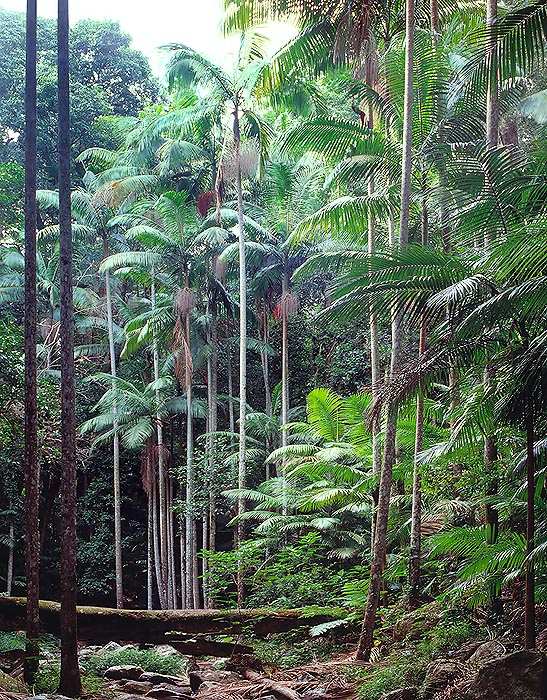Family : Arecaceae

Text © Pietro Puccio

English translation by Mario Beltramini

Archontophoenix cunninghamiana forms thick forests in its habitat © Giuseppe Mazza
The Archontophoenix cunninghamiana H.A. Wendl. & Drude (1875), known as King Palm, Bangalow Palm, and Piccabeen Palm, is native to Queensland and New South Wales (Australia), where it grows up, in the rainy forests, up to an altitude of 1.000 metres.
The name of the genus comes from the Greek “archon” (chief magistrate), and from the name of the palm “phoenix”. The name of the species was dedicated to the botanist Alan Cunningham.
It presents a solitary, dark-grey trunk, tall even 25 metres, slender, of about 25 cm of diameter, often slightly bigger at the base, where are visible the rings, marks of the junctions of the fallen leaves. The foliar base, smooth, with a colour from green to brown-purple, wraps wholly the trunk for a height of about one metre, thus forming a sort of elegant capital.
The leaves are pennate, 2-3 metres long, on a short petiole; pinnules slightly hanging, long 60-90 cm and 5-8 wide, of dark green on both sides.
The huge and showy panicle inflorescence comes out, under the leaves, from a spathe long about 40 cm; the little, but very numerous flowers, are coloured from the pink to the lilac, united in groups of three (a female flower, between two male). The flowers are followed by ovoid fruits, 1-1,5 cm long, with a bright red colour, containing only one seed.
From 2018 Archontophoenix cunninghamiana is inserted in the category LC, Least Concern of the Red List of the International Union for Conservation of Nature (IUCN).
Palm of great ornamental value, due to its slim trunk and the elegant crown of leaves, which recalls tropical landscapes and which results even more decorative during the blossoming and the fructification.
It can be cultivated in open spaces, in sub-tropical and warm-temperate zones, in position partly shaded when young; once adult, it resists till temperatures of about -3 °C, for short periods. It reproduces by seed which germinates easily in about 70 days; it’s of rather fast growth, particularly in fertile and well watered grounds.
Synonyms: Ptychosperma cunninghamianum H.A.Wendl. (1858) – Jessenia amazonum Drude (1882) – Loroma amethystine O.F.Cook (1915) – Loroma cunninghamiana (H.Wendl.) O.F.Cook (1915).
→ For general notions about ARECACEAE please click here.
